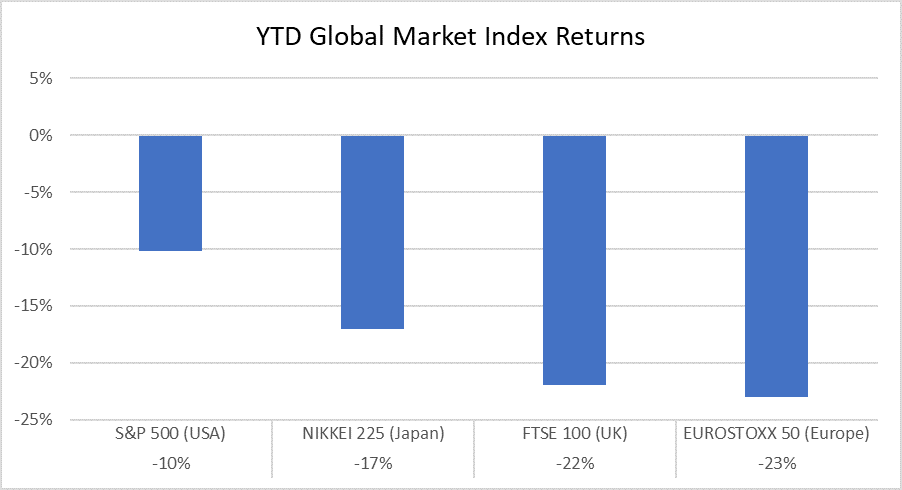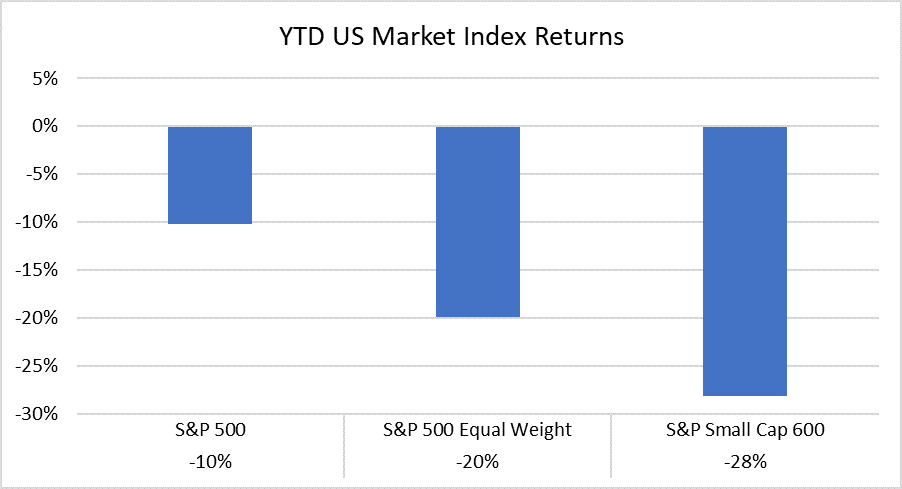The Economy has Largely Stopped: Why is the S&P 500 Only Down 10%?
About a month ago, it became apparent that in order to slow the spread of Covid-19 – buying the necessary time to scale testing and treatment capabilities – the entire global economy would need to be put on pause. The unintended consequences of such a dramatic policy were unknowable, but it was pretty clear that it was going to be a net negative in the short run.
Fast forward to today, and that is what has happened; the economy has ground to a halt, unemployment claims have hit record levels, some businesses have gone bankrupt (with more to come), and no one is certain about the timing of a rebound in growth (we have written extensively about how our long-term philosophy largely saves us the effort of speculating here).
Yet over the last six weeks, the S&P 500 index is up nearly 30%, a huge disconnect from any measure of underlying economic health that you could pick, and substantially ahead of other global markets:

The S&P 500 now stands at less than 10% below the level at the beginning of this year. Does this make sense? Is the market not expecting a recession? Is the Fed propping everything up? And on top of that, if the whole world is facing the same problem, why has the S&P 500 outperformed other global markets?
These are all valid questions. To answer them, we first need to take a step back.
What actually is the S&P 500?
Over the last few decades as passive index investing has grown in prominence, “the S&P 500” has morphed into a standalone investment vehicle. But in reality, we must remember that the S&P 500 is just a collection of the 500 largest companies in the U.S. weighted by their market size – i.e. the higher your market valuation, the larger portion of the index you make up. This simple structure leads to some counterintuitive outcomes.
Firstly, the S&P 500 changes over time. These changes can be substantial, even over a relatively short period of time – members enter, exit, and may represent more or less of the index over time. Just five years ago, information technology made up 15% of the S&P 500 index. Today, it makes up almost 40%.
This sector has grown so fast that the company that creates the S&P 500 index was concerned that passive investors would be put off by this large weighting, so they decided to invent a whole new sector called “Communication Services”, and arbitrarily move some of the companies into that sector instead.
This is nothing but window dressing- the exposure to the underlying companies remains the same however you choose to segment them. Keeping the same companies but moving them into different categories does not diversify or reduce risk- the underlying exposure remains identical. And given the current positioning of the S&P 500, the reality is that when we think of the S&P 500 today, we should think technology.
Another consequence of these substantial changes is that it makes historical comparisons flawed. Comparing the S&P 500 today to the S&P 500 even a few years ago makes little sense – the two are vastly different. So even medium-term performance comparisons become hugely misleading.
Why has technology become so prominent in the index? Well, the information technology sector happens to be dominated by companies like Microsoft, Apple, Alphabet, Amazon and Facebook – all companies that have grown in size and prominence over the last decade, and all companies that are arguably well protected from the shutdowns we have experienced over this past month. In fact, most of these companies are actually benefiting from the shift to work from home paired with their large cash holdings.
What is the impact of all this?
Once we understand that the S&P 500 is mainly influenced by just a small number of companies, whilst also not being well diversified in sector terms, it quickly becomes apparent why the index could be doing so well in the face of an economic crisis.
With a 40% allocation to technology, the S&P 500 is in no way a proxy for the economy, and nor is it a reasonable measure of broad-based stock market performance. Consider that if we take those same 500 companies but weight each one equally (rather than letting the giants dominate), the market would actually be down 20%; twice as bad as the S&P 500. If we expand our view to look at companies too small to feature in the 500, we see a market that is down almost 30% (much more understandable given the state of the economy):

So, in answer to the original question, yes, it is understandable and explainable why the S&P 500 is barely off all-time highs when the economy appears to be crumbling. It is because the S&P 500 itself is not representative of the economy and nor is it representative of whether stocks offer good value or not. What it is a representation of is mainly technology stocks that are benefiting from this current economic lockdown. And those technology stocks are all US homegrown companies- they do not feature in other global markets, hence the S&P’s considerable outperformance vs the rest of the world.
This is why Passive investing is so dangerous – many investors often think they can simply buy a product like the S&P 500 and gain diversified exposure to the market, but what they actually get is a concentrated bet on technology. That itself might not represent good value right now, and it certainly excludes investors from any of the real bargains in the market.
In order to find good value at the moment, investors have to be selective. The best 10 stocks in the S&P 500 have averaged +36% YTD, the worst 10 have averaged -69%; so there is clearly huge divergence within the 500 companies themselves – but all of that is missed by the index level itself. To be able to invest in undervalued companies right now investors have to be active, they can’t just buy the index- because the index has barely fallen from its long-term highs. Passive investing may be low cost for investors – but as with everything in life, you get what you pay for.
The only way to truly invest prudently and with a margin of safety is to do the hard work of actually understanding each individual stock and whether or not it is a good value today. Relying on one single index like the S&P 500 to give you a representation of what is happing with either the economy or stock valuations is very misleading indeed.
Disclosures: This website is for informational purposes only and does not constitute an offer to provide advisory or other services by Globescan in any jurisdiction in which such offer would be unlawful under the securities laws of such jurisdiction. The information contained on this website should not be construed as financial or investment advice on any subject matter and statements contained herein are the opinions of Globescan and are not to be construed as guarantees, warranties or predictions of future events, portfolio allocations, portfolio results, investment returns, or other outcomes. Viewers of this website should not assume that all recommendations will be profitable, or that future investment and/or portfolio performance will be profitable or favorable. Globescan expressly disclaims all liability in respect to actions taken based on any or all of the information on this website.
There are links to third-party websites on the internet contained in this website. We provide these links because we believe these websites contain information that might be useful, interesting and or helpful to your professional activities. Globescan has no affiliation or agreement with any linked website. The fact that we provide links to these websites does not mean that we endorse the owner or operator of the respective website or any products or services offered through these sites. We cannot and do not review or endorse or approve the information in these websites, nor does Globescan warrant that a linked site will be free of computer viruses or other harmful code that can impact your computer or other web-access device. The linked sites are not under the control of Globescan, and we are not responsible for the contents of any linked site or any link contained in a linked site. By using this web site to search for or link to another site, you agree and understand that such use is at your own risk.






